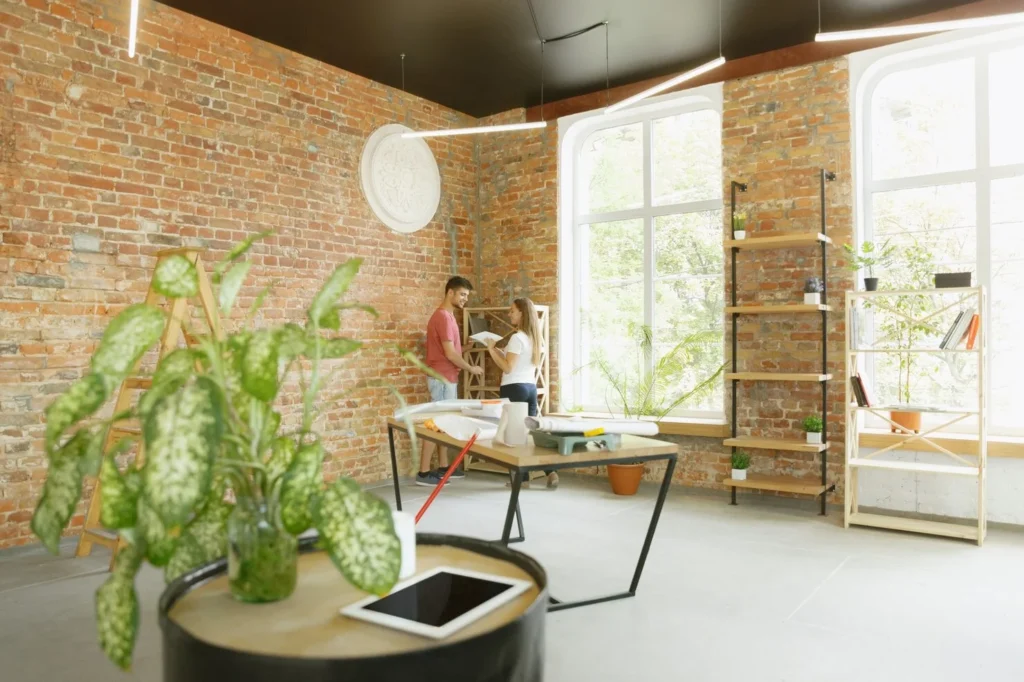In Ontario, businesses are increasingly investing in commercial building renovation to create workspaces that boost productivity, foster collaboration, and attract top talent. Modern offices are now more than just places to work—they’re environments that reflect a company’s values, prioritize employee well-being, and adapt to the needs of today’s dynamic workforce. Here are some of the top commercial renovation trends shaping Ontario’s modern workspaces.
1. Open and Flexible Floor Plans
Gone are the days of rigid, compartmentalized office layouts. Open floor plans that encourage collaboration and flexibility are now a top choice for many businesses. This trend embraces an adaptable approach, with movable walls, modular furniture, and flexible spaces that can be quickly reconfigured for different tasks.
Benefits of Open Floor Plans:
- Encourages teamwork and open communication
- Provides flexibility for teams to rearrange spaces as needed
- Accommodates hybrid work setups, including hot-desking and communal areas
This style allows businesses to adapt to growth and changing needs without needing a full renovation, making it a cost-effective option for companies that anticipate expansion.
2. Biophilic Design Elements
Incorporating natural elements into commercial spaces is a growing trend that enhances employee well-being and productivity. Biophilic design focuses on bringing elements like plants, natural light, and water features into the workspace. Studies show that biophilic design can reduce stress, improve air quality, and foster a sense of calm, making it a valuable addition to any commercial building renovation.
Popular Biophilic Elements:
- Indoor plants and green walls
- Large windows for natural light
- Natural materials such as wood, stone, and water features
This trend aligns with sustainability goals, making it particularly popular among companies looking to reduce their environmental footprint.
3. Dedicated Collaboration Zones
With the rise of collaborative work styles, creating dedicated spaces for team interaction has become a priority in modern workspaces. These collaboration zones are specifically designed for brainstorming, project planning, and group discussions, promoting creativity and innovation.
Features of Collaboration Zones:
- Comfortable seating, like couches and armchairs, to encourage relaxed interactions
- Interactive whiteboards and digital screens for real-time presentations
- Acoustic panels and soundproofing to minimize distractions
These zones can be both formal and informal, accommodating everything from scheduled meetings to impromptu discussions.
4. Smart Technology Integration
Technology is at the heart of any modern workspace, and commercial renovations now emphasize seamless tech integration. From smart lighting and HVAC systems to high-speed connectivity and automated meeting rooms, Ontario businesses are adopting technology to create more efficient and convenient work environments.
Key Smart Technology Trends:
- Automated lighting and climate control systems for energy efficiency
- High-speed Wi-Fi and network access for flexible work arrangements
- Video conferencing technology to support remote teams
These tech-driven upgrades not only enhance productivity but also reduce long-term operational costs by improving energy efficiency.
5. Focus on Wellness Spaces
As businesses place more importance on employee health, wellness spaces have become a staple in commercial building renovations. These areas are designed for relaxation, mental well-being, and physical activity, providing employees with a balanced work environment.
Examples of Wellness Spaces:
- Meditation rooms or quiet zones for stress relief
- On-site fitness rooms or yoga studios
- Relaxation areas with comfortable seating and soft lighting
Creating dedicated wellness areas shows employees that their health and happiness matter, which can lead to higher job satisfaction and reduced burnout.
6. Sustainable and Eco-Friendly Design
Sustainability is a core focus for many companies today, and green building practices are at the forefront of commercial renovations in Ontario. Incorporating sustainable materials, energy-efficient systems, and waste reduction practices helps businesses lower their environmental impact while creating healthier spaces.
Sustainable Design Elements:
- Energy-efficient lighting and HVAC systems
- Recycled or renewable materials for finishes and furnishings
- Water-saving fixtures and appliances
This trend resonates with clients, employees, and stakeholders who value environmental responsibility, making it both a practical and ethical choice.
7. Emphasis on Acoustics and Sound Management
With open floor plans becoming more common, managing noise levels is essential for maintaining productivity. Acoustic design has become a critical aspect of commercial building renovation, focusing on reducing noise through thoughtful layout, materials, and soundproofing.
Acoustic Solutions in Modern Workspaces:
- Acoustic panels and ceiling tiles to absorb sound
- Soundproofing in meeting rooms and quiet areas
- Floor layouts that separate high-traffic areas from focused workspaces
By investing in sound management, businesses can ensure that open floor plans don’t compromise employee focus or comfort.
8. Enhanced Break Rooms and Social Spaces
Modern workplaces recognize the importance of social interaction for building a positive office culture. Break rooms and social spaces are no longer just functional but are now designed for relaxation, interaction, and team-building.
Key Features of Modern Social Spaces:
- Coffee bars, snack stations, or even mini-kitchens
- Game areas with options like foosball tables or board games
- Open seating arrangements to encourage spontaneous gatherings
These spaces promote a sense of community, helping employees feel connected to their peers and more engaged in their work.
9. 3D Visualization and Design Tools for Planning
Before the renovation begins, many companies are now using 3D visualization tools to plan and visualize their new space. This technology enables business owners to see a realistic representation of the completed project, making it easier to make design choices and ensure the final product aligns with their vision.
Benefits of 3D Visualization:
- Allows clients to make informed design decisions
- Provides a clear understanding of layout and space utilization
- Helps identify potential issues early in the planning stage
This trend in renovation planning offers a more transparent and collaborative approach to designing commercial spaces.
10. Brand-Centric Design and Customization
Today’s businesses want their workspaces to reflect their brand identity and values. Renovations that incorporate branding elements—such as logos, brand colors, and personalized decor—create a space that aligns with a company’s mission and resonates with clients and employees alike.
Elements of Brand-Centric Design:
- Color schemes that reflect the company’s branding
- Custom wall art, logos, or graphics
- Branded decor and furniture that complement the brand’s aesthetic
Brand-centric design helps foster a sense of pride and belonging among employees, as well as a strong impression on visiting clients.
Conclusion
In Ontario, modern workspaces are evolving to support flexibility, sustainability, wellness, and technology. Choosing the right commercial building renovation approach can help businesses create environments that align with these trends, enhancing both employee satisfaction and operational efficiency. By embracing these top commercial renovation trends, companies can position themselves for success, creating spaces that inspire productivity and reflect their values.
Modernizing a workspace can bring numerous long-term benefits, from improved employee morale to a more streamlined workflow. As Ontario businesses continue to innovate, investing in a well-planned commercial renovation will be key to staying competitive and creating lasting impressions in today’s dynamic market.







